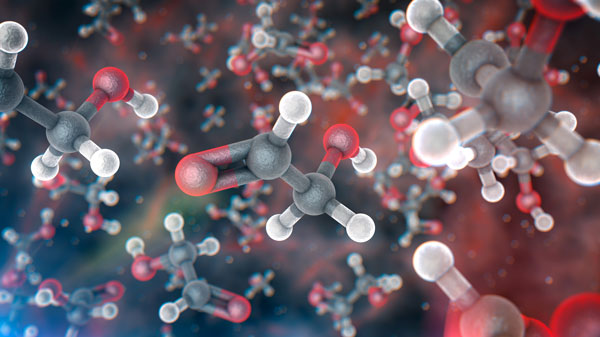Detecting lines in the universe
Astronomers discovered that sugar molecules, one of the basic substances that make up life, are close to a star whose mass is equal to the sun.
'We detected glycolaldehyde, a simple form of sugar, in the disk of dust and gas around this newly formed star. The amount of sugar that we detected is roughly the amount of sugar that we pour into the cup of coffee. Glycolaldehyde is one of the substances that make up RNA. Like DNA, RNA is one of the basic components of life , 'said Jes Jorgensen, a scientist at the Niels Bohr Institute in Denmark.
The new star, called IRAS 16293-2422 , is a member of the binary star system, Space reported. It has the same mass as the sun and lies away from the constellation Ophiuchus. Astronomers have discovered glycolaldehyde sugars in interstellar space, but this is the first time they have detected them very close to a star.

Illustration of glycolaldehyde sugar molecules. (Photo: Space)
In fact, the distance from the sugar molecules to the star is equivalent to the distance from the Uranus star to the sun.
Cécile Favre, a researcher at Aarhus University in Denmark, said astronomers discovered sugar molecules after using the Atacama Large Millimeter telescope in Chile. They track the sugar molecules and realize they are moving toward one of the two stars of the binary star system.
When stars were born, clouds of dust and gas - which created the star - became very cold. Most of the gas turns into ice and blends into dust particles. Then the ice molecules and dust molecules joined together, creating complex molecules, the researchers explained.
During the development of stars, the heat from them heats the inner space of the dust and gas clouds around them. When the temperature rises to a certain threshold, complex organic molecules evaporate and form gasses capable of emitting radiation. Ground-based radio telescopes can 'catch' those radiation.
Because IRAS 16293-2422 is relatively close to the earth, scientists can study sugar molecules and the chemical composition of dust and gas around the young star. Advanced devices, such as radio telescopes, will help them see the reactions of those molecules as they participate in the process of making planets.
- Strange lines of striped clouds in Australia's sky
- The reason why power lines are dimmed
- Interesting animations on product production lines
- Detecting mysterious dark flows in the universe
- Why do fish have diagonal lines on the body?
- Power lines make honey bees more violent
- We live in the end of the universe
- Draw lines for robbers
- Detecting the 4th dimension of gravity in the universe
- Detecting huge black holes revealing the universe at the age of cradle
- Sea cucumber in Vietnam: Detecting active ingredients inhibiting cancer
- The things you do every day will become very 'weird' when you are in the universe
 Van Allen's belt and evidence that the Apollo 11 mission to the Moon was myth
Van Allen's belt and evidence that the Apollo 11 mission to the Moon was myth The levels of civilization in the universe (Kardashev scale)
The levels of civilization in the universe (Kardashev scale) Today Mars, the sun and the Earth are aligned
Today Mars, the sun and the Earth are aligned The Amazon owner announced a secret plan to build a space base for thousands of people
The Amazon owner announced a secret plan to build a space base for thousands of people